
Concept explainers
Draw the structure for each of the following:
- a. isobutyraldehyde
- b. diisopentyl
ketone - c. 3-methylcyclohexanone
- d. 2,4-pentanedione
- e. 4-bromo-3-heptanone
- f. 4-bromohexanal
(a)
Interpretation:
The structure of Isobutyraldehyde has to be drawn.
Concept Introduction:
For any given organic compound name, the corresponding structure can be analysed and drawn by analysing or identifying the following aspects of the name:
- Parent chain.
- Functional group.
- Position of the functional group on the parent chain.
- Alkyl substituent.
- Position of the alkyl substituent on the parent chain.
Answer to Problem 28P
The structure of Isobutyraldehyde is given below:
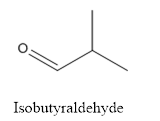
Explanation of Solution
The compound has aldehyde group that is attached to the isobutyl group.
The structure of isobutyraldehyde is as follows.

(b)
Interpretation:
The structure of diisopentyl ketone has to be drawn.
Concept Introduction:
For any given organic compound name, the corresponding structure can be analysed and drawn by analysing or identifying the following aspects of the name:
- Parent chain.
- Functional group.
- Position of the functional group on the parent chain.
- Alkyl substituent.
- Position of the alkyl substituent on the parent chain.
Answer to Problem 28P
The structure of diisopentyl ketone is given below:
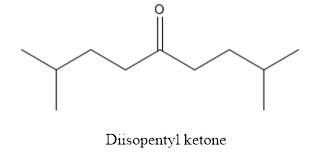
Explanation of Solution
The compound has ketone functional group. Two isopentyl groups are attached to the keto group.
The structure of diisopentyl ketone is as follows.

(c)
Interpretation:
The structure of 3-methylcyclohexanone has to be drawn.
Concept Introduction:
For any given organic compound name, the corresponding structure can be analysed and drawn by analysing or identifying the following aspects of the name:
- Parent chain.
- Functional group.
- Position of the functional group on the parent chain.
- Alkyl substituent.
- Position of the alkyl substituent on the parent chain.
Answer to Problem 28P
The structure of 3-methylcyclohexanoneis given below:
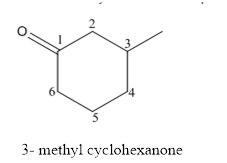
Explanation of Solution
The compound has ketone functional and group and it is cyclohexanone that has one methyl group at 3rd position of the cyclic ring.
The structure of 3-methyl cyclohexanone is as follows.

(d)
Interpretation:
The structure of 2,4-pentanedione has to be drawn.
Concept Introduction:
For any given organic compound name, the corresponding structure can be analysed and drawn by analysing or identifying the following aspects of the name:
- Parent chain.
- Functional group.
- Position of the functional group on the parent chain.
- Alkyl substituent.
- Position of the alkyl substituent on the parent chain.
Answer to Problem 28P
The structure of 2,4-pentanedione is given below:
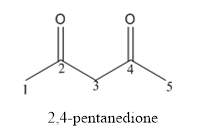
Explanation of Solution
The compound has two keto functional groups and these are attached to the pentane carbon chain.
The structure of 2,4-pentanedione is as follows:

(e)
Interpretation:
The structure of 4-bromo-3-heptanone has to be drawn.
Concept Introduction:
For any given organic compound name, the corresponding structure can be analysed and drawn by analysing or identifying the following aspects of the name:
- Parent chain.
- Functional group.
- Position of the functional group on the parent chain.
- Alkyl substituent.
- Position of the alkyl substituent on the parent chain.
Answer to Problem 28P
The structure of 4-bromo-3-heptanone is given below:
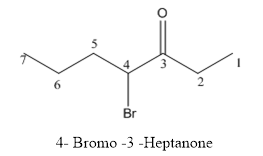
Explanation of Solution
The compound has keto functional group and it is attached to the heptane carbon chain. At the 4th position of the carbon chain has bromine attachment.

(f)
Interpretation:
The structure of 4-bromohexenal has to be drawn.
Concept Introduction:
For any given organic compound name, the corresponding structure can be analysed and drawn by analysing or identifying the following aspects of the name:
- Parent chain.
- Functional group.
- Position of the functional group on the parent chain.
- Alkyl substituent.
- Position of the alkyl substituent on the parent chain.
Answer to Problem 28P
The structure of 4-bromohexenal is given below:

Explanation of Solution
The compound has bromine functional group at the 4th position from the aldehyde functional group on the hexane parent chain.
The structure of 4-bromohexenal is as follows:

Want to see more full solutions like this?
Chapter 12 Solutions
Essential Organic Chemistry Study Guide & Solution Manual, Books a la Carte Edition
- 10- 4000 20 20 30- %Reflectance 60 50- 09 60- 40- Date: Thu Feb 06 17:30:02 2025 (GMT-05:0(UnknownP Scans: 8 Resolution: 2.000 70 70 88 80 3500 3000 2500 90 100 00 Wavenumbers (cm-1) 2000 1500 2983.10 2359.13 1602.52 1584.22 1451.19 1391.87 1367.07 1314.37 1174.34 1070.13 1027.33 1714.16 1269.47 1000 1106.08 1001.14 937.02 873.60 850.20 780.22 686.91 674.38 643.09 617.98 02/06/25 16:38:20arrow_forwardd. Draw arrow-pushing mechanism for an enzymatic retro-aldol reaction of the following hexose. Use B: and/or HA as needed. OH OH سية HO OH OHarrow_forward4. Calculate the wavelength of a photon needed to excite a transition between neighbouring energy levels of a harmonic oscillator of effective mass equal to that of an oxygen atom and with a force constant of 544 N m¹.arrow_forward
- 2. Identify the strongest type of intermolecular force that exists between each pair of compounds: a. Ammonium chloride / H₂O b. OH C. d.arrow_forwardREPORT FOR EXPERIMENT 9 (continued) NAME F. Solubility vs. Temperature; Saturated and Unsaturated Solutions Data Table: Circle the choices which best describe your observations. NaCl 1.0 g +5 mL water 1.0 g +5 mL water +1.4 g dissolved completely? yes/no saturated or unsaturated? dissolved completely? yes/no saturated or unsaturated? 2.4 g +5 mL water +heat dissolved completely? yes/no saturated or unsaturated? 2.4 g +5 mL water after cooling dissolved completely? yes/no saturated or unsaturated? NHC dissolved completely? yes/no saturated or unsaturated? dissolved completely? yes/no saturated or unsaturated? dissolved completely? yes/no saturated or unsaturated? dissolved completely? yes/no saturated or unsaturated? G. Ionic Reactions in Solution 1. Write the word and formula equations representing the chemical reaction that occurred between the barium chloride solution, BaCl,(aq), and the sodium sulfate solution, Na SO (aq). Word Equation: Formula Equation: 2. (a) Which of the…arrow_forwardIn the drawing areas below, draw the two most expected stable conformations of the following molecule: ייון Be sure your drawings make it possible to distinguish between the conformations. After you've drawn the conformations, answer the question below the drawing areas. Х S : ☐ ☑ 5arrow_forward
- Add curved arrows to show the forming and breaking of bonds in the reaction below. :Br: H 2 Add/Remove step ☑ H-Br: G હે Parrow_forwardPlease correct answer and don't use hand ratingarrow_forwardSafari File Edit View History Bookmarks Window Help く < mylabmastering.pearson.com Wed Feb 12 8:44 PM ✩ + Apple Q Bing Google SignOutOptions M Question 36 - Lab HW BI... P Pearson MyLab and Mast... P Course Home Error | bartleby b Answered: If the biosynth... Draw a free-radical mechanism for the following reaction, forming the major monobromination product: ScreenPal - 2022 CHEM2... Access Pearson 2 CH3 Br-Br CH H3 Draw all missing reactants and/or products in the appropriate boxes by placing atoms on the canvas and connecting them with bonds. Add charges where needed. Electron- flow arrows should start on the electron(s) of an atom or a bond and should end on an atom, bond, or location where a new bond should be created. Include all free radicals by right-clicking on an atom on the canvas and then using the Atom properties to select the monovalent radical. ▸ View Available Hint(s) 0 2 DE [1] H EXP. CONT. H. Br-Br H FEB 12arrow_forwardarrow_back_iosSEE MORE QUESTIONSarrow_forward_ios
 ChemistryChemistryISBN:9781305957404Author:Steven S. Zumdahl, Susan A. Zumdahl, Donald J. DeCostePublisher:Cengage Learning
ChemistryChemistryISBN:9781305957404Author:Steven S. Zumdahl, Susan A. Zumdahl, Donald J. DeCostePublisher:Cengage Learning ChemistryChemistryISBN:9781259911156Author:Raymond Chang Dr., Jason Overby ProfessorPublisher:McGraw-Hill Education
ChemistryChemistryISBN:9781259911156Author:Raymond Chang Dr., Jason Overby ProfessorPublisher:McGraw-Hill Education Principles of Instrumental AnalysisChemistryISBN:9781305577213Author:Douglas A. Skoog, F. James Holler, Stanley R. CrouchPublisher:Cengage Learning
Principles of Instrumental AnalysisChemistryISBN:9781305577213Author:Douglas A. Skoog, F. James Holler, Stanley R. CrouchPublisher:Cengage Learning Organic ChemistryChemistryISBN:9780078021558Author:Janice Gorzynski Smith Dr.Publisher:McGraw-Hill Education
Organic ChemistryChemistryISBN:9780078021558Author:Janice Gorzynski Smith Dr.Publisher:McGraw-Hill Education Chemistry: Principles and ReactionsChemistryISBN:9781305079373Author:William L. Masterton, Cecile N. HurleyPublisher:Cengage Learning
Chemistry: Principles and ReactionsChemistryISBN:9781305079373Author:William L. Masterton, Cecile N. HurleyPublisher:Cengage Learning Elementary Principles of Chemical Processes, Bind...ChemistryISBN:9781118431221Author:Richard M. Felder, Ronald W. Rousseau, Lisa G. BullardPublisher:WILEY
Elementary Principles of Chemical Processes, Bind...ChemistryISBN:9781118431221Author:Richard M. Felder, Ronald W. Rousseau, Lisa G. BullardPublisher:WILEY





